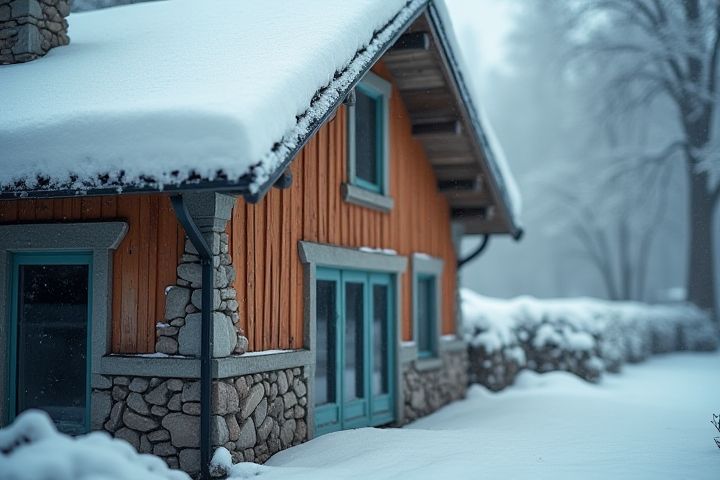
Several factors can contribute to your house feeling cold, impacting your comfort and heating efficiency. Insufficient insulation in walls, attics, or floors can lead to significant heat loss, causing drafts and lower temperatures indoors. Old or faulty windows may lack proper sealing, allowing cold air to seep in, while warm air escapes. The efficiency of your heating system plays a vital role; an outdated furnace or poorly maintained heating unit can struggle to keep your home adequately warm. Assessing and addressing these issues can help create a cozier environment, improving your overall energy efficiency and comfort.
Why Is My House Always Cold
Poor insulation
Poor insulation can lead to significant heat loss, causing your house to feel cold even during warmer months. In fact, up to 30% of heat can escape through inadequately insulated walls and attics. This not only impacts your comfort but also increases energy bills, with heating costs potentially rising by 10% to 20% in poorly insulated spaces. Inspecting and upgrading your insulation can enhance thermal performance, making your home cozier while saving you money.
Drafty windows
Drafty windows can lead to significant heat loss in your home, often accounting for up to 30% of your overall energy bill. Poor insulation or outdated window technologies, like single-pane glass, exacerbate this issue, allowing cold air to seep inside while warm air escapes. Simple solutions include applying weather stripping or insulation film, which can improve thermal efficiency and enhance comfort. Investing in double or triple-pane windows can yield long-term energy savings, decreasing your heating costs by hundreds of dollars annually.
Inadequate heating system
An inadequate heating system can significantly impact your home's temperature, often leading to persistent coldness during winter months. If your unit is outdated or improperly sized for your space, it may struggle to maintain a comfortable environment, leaving certain areas significantly cooler. Regular maintenance, such as checking for leaks in ducts or ensuring efficient operation of your furnace, is essential, as approximately 25-30% of heated air can escape through these openings. Upgrading to a more efficient heating system, such as a high-efficiency furnace or modern heat pump, can enhance warmth and reduce your energy bills by up to 30%.
High ceilings
High ceilings can contribute to your house feeling cold due to the tendency of warm air to rise, leaving the lower living areas cooler. As warmth accumulates at the ceiling level, it creates an imbalance in temperature, resulting in chilly spots throughout the space. Insulation and heating systems that are inadequate for high-ceilinged rooms struggle to maintain consistent warmth, which can lead to increased energy consumption. Consider using ceiling fans or supplemental heating sources to help circulate warm air and enhance comfort in your home.
Incorrect thermostat settings
Incorrect thermostat settings can lead to your house feeling constantly cold, as an improperly set thermostat may result in insufficient heating. If the thermostat is set too low, it won't engage your heating system effectively, leaving you with chilly indoor temperatures. Additionally, if the thermostat is incorrectly calibrated or placed in a drafty area, it may inaccurately read the temperature, causing the heating system to underperform. Regularly checking and adjusting your thermostat settings to ensure they align with your comfort preferences can help maintain a warmer environment in your home.
Leaky ductwork
Leaky ductwork accounts for 20% to 30% of your heating and cooling costs, significantly impacting your home's temperature stability. When air escapes through gaps or holes in the ducts, your HVAC system works harder, leading to inefficiency and inconsistent heating. This not only causes your home to feel cold but also increases energy bills, with potential savings of 10% to 30% by sealing the leaks. Consider annual inspections of your ductwork to ensure optimal performance and comfort in your living spaces.
Cold floors
Cold floors in your house can be attributed to several factors, including inadequate insulation, air leaks, and the type of flooring material. Insufficient insulation in your crawl space or basement can lead to heat loss, causing your floors to feel chilly. If your home has hardwood or tile flooring, these materials can absorb cold temperatures from the ground, making them less comfortable underfoot. To improve warmth, consider installing area rugs, sealing gaps around windows and doors, or adding insulation beneath your flooring to create a cozier environment.
Lack of sunlight
Houses lacking ample sunlight often experience lower indoor temperatures, leading to a consistently cold atmosphere. Insufficient sunlight not only affects your home's heating but may also result in higher energy costs as you rely more on heating systems. The absence of sunlight can be attributed to factors such as surrounding tall trees, neighboring structures, or inadequate window placement, preventing natural warmth from penetrating your living space. To counteract this chill, consider adding reflective window films or optimizing your home's layout to maximize light exposure.
Overexposure to wind
Overexposure to wind can significantly impact your home's temperature, making it feel consistently cold. Drafts can infiltrate through gaps in windows, doors, or poorly insulated walls, lowering your indoor temperature by up to 5degF. Wind pressure can also aggravate these breaches, increasing heat loss and draftiness in your living spaces. To combat this, consider weatherstripping or upgrading insulation to minimize the effects of harsh gusts and maintain a cozier environment.
Closed vents
Closed vents can significantly contribute to a cold house, as they restrict warm air from circulating throughout your living space. If you're experiencing consistently low temperatures, check all vents in each room to ensure they are open and unobstructed. Remember, approximately 20% of the total heat loss in a home can occur due to poor airflow, often exacerbated by closed or blocked vents. Regularly inspecting and adjusting your vents can help maintain a comfortable temperature and improve overall energy efficiency.
